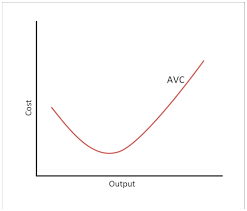RELATIONSHIP BETWEEN AC AND MC
AVERAGE COST
Average total cost is the sum of the average fixed cost and average variable cost. Alternatively, ATC is computed by dividing total cost by the number of units of output.
Therefore,
ATC or AC = AFC + AVC
=TC/Q
Average cost is also known as unit cost, as it is cost per unit of output produced. It can be shown as follows:

Average cost is inclusive of Average Fixed Cost and Average Variable Cost.
AVERAGE FIXED COST: AFC is the average of total fixed costs. AFC can be obtaining by dividing the total fixed cost by total quantity of output each time produced. Mathematically,
AFC = TFC /quantity
TFC will be always fixed. So AFC will reduce and never reaches zero. Its curve is as follows:

AVERAGE VARIABLE COST: AVC is the average of total variable cost. It can be find out by using the following formula.
AVC = TFC / quantity
AVC curve will be a ‘U’ shaped which is showing that when the output is raises the cost will decline, but after a certain level the cost starts to increases. That is why due to the variable proportion.

MARGINAL COST
It is the addition to total cost required to produce one additional unit of a commodity. It is measured by the change in total cost resulting from a unit increase in output. For example, if the total cost of producing 5 units of a commodity is Rs. 100 and that of 6 units is Rs. 110, then the marginal cost of producing 6th unit of. Commodity is Rs. 110 – Rs. 100 = Rs. 10. The formula for marginal cost is
MCn =TCn –TCn-1,
It means that marginal, cost of ‘n’ units of output (MCn) can be obtained by subtracting the total cost of production of ‘n-l’ units (TCn-1) from the total cost of production of ‘n’ units (TCn). Alternatively, marginal cost can be expressed as
MC=∆TC/∆Q.
Here, ∆TC stands for change in total cost and ∆Q stands for change in total output.
This can be shown as follows:

RELATIONSHIP BETWEEN AC AND MC
(1) Average Cost and Marginal Cost can be calculated from Total Cost:
Average cost and marginal cost can be calculated from total cost. As is known, average cost is the ratio of total cost to total output. In other words, AC is calculated by dividing the total cost by the quantity of output. It means.
AC = TC / Q
In the same way, marginal cost can also be calculated from total cost. It refers to an addition made to total output by producing one more unit of output. Thus,
MC = TCn – TC n-1
MC = ∆TC / ∆Q
When average cost falls, MC also falls:
In this situation, rate of fall in marginal cost is more than fall in average cost. In other words, when AC curve is falling, MC curve will be below it. The reason behind this is that whereas average cost is the aggregate of average fixed cost and average variable cost, marginal cost refers only to change in average variable cost.
(3) When AC rises, MC also rises:
When average cost curve rises, marginal cost too rises, but rate of increase in marginal cost is more than that of average cost.

(4) MC cuts AC at its Lowest Point:
Marginal cost is equal to average cost when the latter is at its minimum. The minimum point of marginal cost occurs earlier than the average cost.
(5) When AC is constant MC becomes equal to AC:
When AC is constant, marginal cost first increases and then becomes equal to it. Figure 9 shows the picture more vividly.
(6) Use of MC and AC in Price Determination:
The concept of marginal cost is of great significance in finding out equilibrium output and that of average cost in finding out profit and loss. Equilibrium output is one at which marginal cost is equal to marginal revenue.
A firm earns normal profit when its average cost is equal to average revenue. It earns supernormal profit when average revenue is more than average cost. Moreover, a firm earns losses when average cost is more than average revenue.
(7) Mutual Interaction between MC and AC:
When marginal cost is more than average cost, average cost has a tendency to rise. It seems as if marginal cost curve is pulling the AC curve upward. On the other hand, when MC is less than AC, it pulls the AC curve downward. When MC is equal to AC then the latter is constant.
